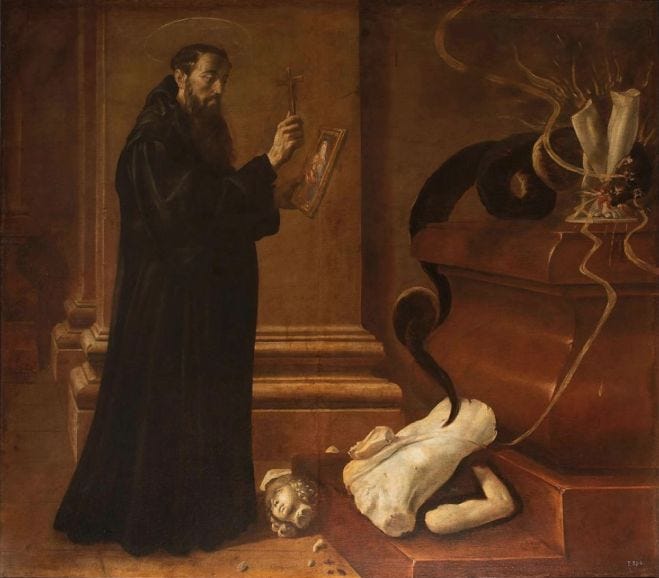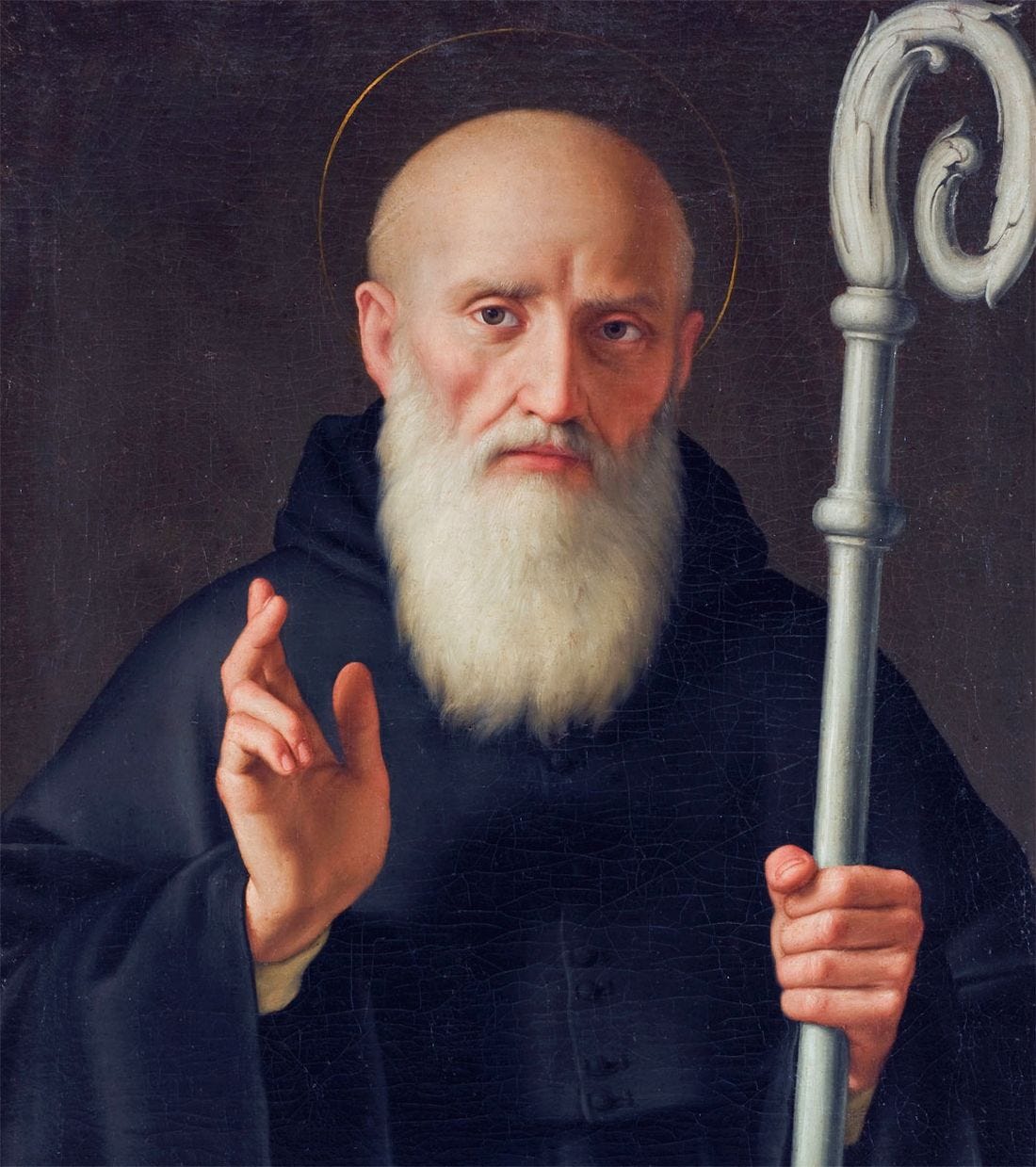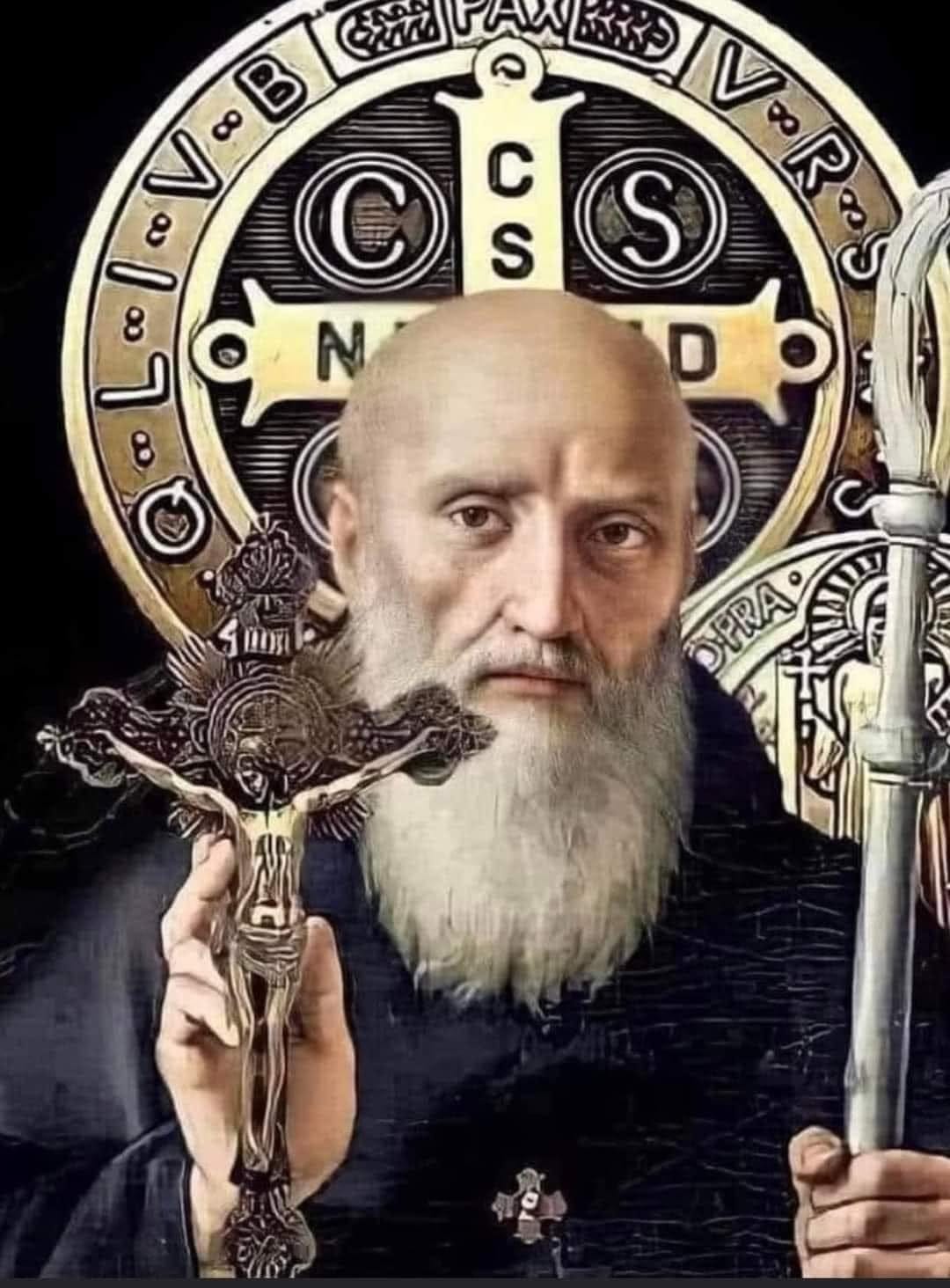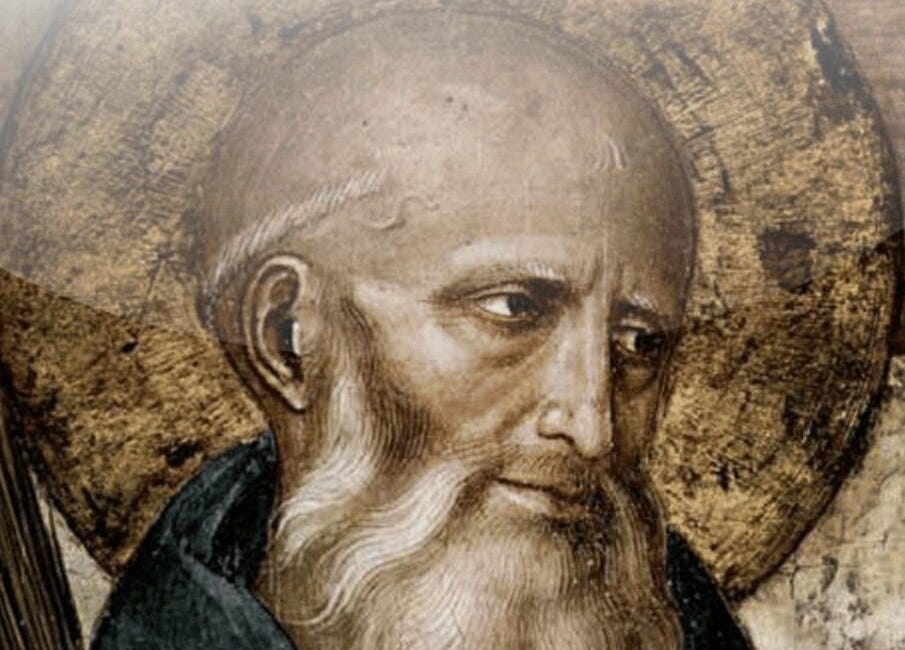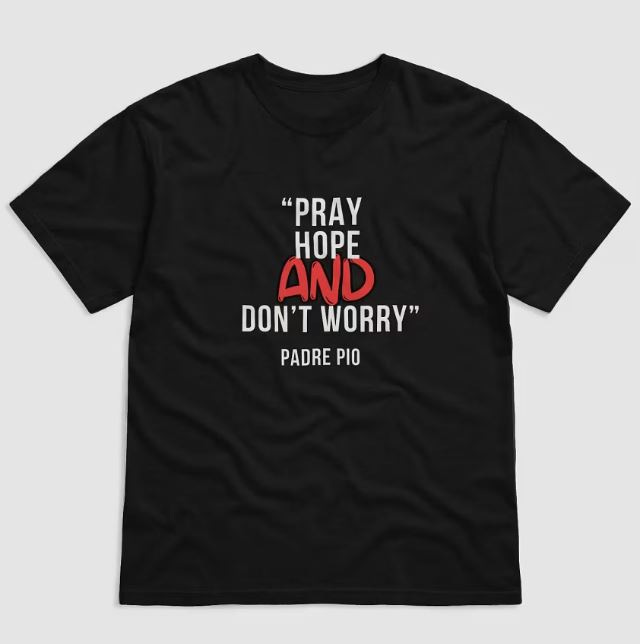Today, July 11, 2025, is the Feast Day of Saint Benedict in the new Calendar. It’s celebrated in the Old Calendar on March 21, the date he passed.
This is something I wrote back in 2022, now updated with an audio podcast, images. and a brief bio (at the end).
Don’t “sleep” on this! It has helped me avoid being poisoned as well!
Have you ever watched someone make the sign of the cross right before a meal? Do you do that yourself?
I am sure they are doing it with good intentions. They might be simply taking a moment to thank God for blessing them with their meal and feel fortunate to have one. Maybe they are reminded of God supplying them with their daily bread and trying to keep God Present in every facet of their life.
For me, making the sign of the cross before a meal has become a ritual I do on a regular basis. It was taught to me by my grandmother, and so I just did it for years. I never thought about it, I just did as I was taught.
As my journey progressed, I was introduced to sacramentals. They came my way in very synchronistic ways, and so I appreciated their value more. The feelings and impression they made on me impacted me differently than the way I may have been exposed to them if man had introduced me to them.
All my years of Catholic education, I had never been taught about the sacramentals. They may have been mentioned and glanced over during readings on Saints, but they were never explained or focused on.
I believe this was done with intentions. Intentions to keep them away from me because they contain the reinforcements needed to take my faith deeper. The sacramentals are complements to the sacraments and commandments. They are reminders to help stay the course with the goal of helping one reach the thin and narrow gate that so few find.
Let’s look at a particular sacramental and try to apply it to my mention of making the sign of the cross before a meal.
The Saint Benedict medal is a medal that originated from the life experiences of Saint Benedict. If you look at the front of the medal, it contains an image of a cup.
This represents a cup of wine given to Saint Benedict that was poisonous.
He made the sign of the cross before drinking it, and the glass broke. He used the sign of the cross to perform many miracles.
On the opposite side of the medal (meaning opposite of where the cup is located), some kind of bird can be seen.
This is to represent the story of how God had a bird snatch some bread he was about to eat that was tainted with poison sent from his enemies.
On the medal itself, it contains a form of an exorcism prayer on it to ward off the enemy of his attacks. This reinforces your original baptism rite and walks with you as you travel and go about your day-to-day.
The medal has become common in recent years, but it is actually an acceptable and approved replacement for wearing the Saint Benedict Scapular.
As you can see, this sacramental contains the history of the faith. It contains true stories demonstrating the power of the Holy Cross.
At the end of the day, the sacramental is leading you right back to Jesus! This is the beauty of the Catholic Faith. Everything, including and especially the Mother of Jesus, is designed to lead you back to Jesus, particularly his sacrifice on the cross for the salvation of your soul.
It’s designed to bring you to His Church.
He created it to be Universal for all. The ultimate reminder of Christ is what happens at the altar at every Mass said. It’s the ultimate meal you should give thanks for daily!
Making the sign of the cross before a meal, if you are armed with the history of the Saints, gives it so much more meaning and power, in my opinion.
You are not just thanking God for the meal, you are warding off any potential issues with even the food preparations or food contamination. If you are wearing a Saint Benedict medal and you are aware of its meaning and history, then you can use this to do much more.
If you have a close relationship with your guardian Angel, you might get this weird feeling not to eat the food before you begin your meal. This feeling is your guardian angel getting divine assistance from Saint Benedict in heaven, trying to alert you.
Some will say this is your "intuition," but this is a form of debate the devil is instigating to cause division, discord, and chaos.
Your intuition comes from God.
I hope this helps "justify" the use of sacramentals in one’s life and brings an urgency for others to explore with conviction. Catholics don’t worship medals and statues as some people claim.
There is a rich meaning and heritage behind the sacramentals. There are stories behind them that have meaning and purpose.
The level of intercession using the sacramentals depends on your level of belief and faith. The more you believe, the stronger that "sick sense" will help guide and protect you.
"From the cradle to the grave, we have a guardian angel assigned to us."
From its beginning until death, human life is surrounded by their watchful care and intercession. “Beside each believer stands an angel as protector and shepherd leading him to life.” Already here on earth the Christian life shares by faith in the blessed company of angels and men united in God. (CCC 336)
Don’t wait until it’s too late to form a bond with your best friend. You will live to regret it.
See that you do not despise one of these little ones, for I say to you that their angels in heaven always look upon the face of my heavenly Father. (Mt.18:10)
Sacramentals are sacred signs instituted by the Church. They prepare men to receive the fruit of the sacraments and sanctify different circumstances of life. (Catechism of the Catholic Church 1677)
Click here for an explanation of the Medal from The Catholic Company
St Benedict Of Nursia
St. Benedict of Nursia (480-547 A.D.) and his twin sister, St. Scholastica, were born to a Roman nobleman and his wife in Nursia, Italy. He spent his childhood with his parents in Rome. As a young man he found in himself a strong desire to escape the trifling things of the world and serve God. He left his family and wealth and settled in the mountainous region of Subiaco. After three years living in solitude as a cave-dwelling hermit, he was asked to lead a monastery in the place of an abbot who had died. Benedict did as they asked, but his way of life was too extreme for the monks and they tried to poison him. He thwarted their evil designs by blessing the poisoned cup, rendering it ineffective. Benedict returned to his cave, where news of his sanctity and miracles began to spread. Soon a community of men surrounded him wanting to adopt his way of life. To house them Benedict established twelve monasteries, including the world-famous Monte Cassino, and gave them a rule of life to live by, known as the Rule of St. Benedict. His Rule—still observed by Benedictines today—helped form the civilization and culture of Europe. Because of the organization, structure, and discipline he brought to the monastic life, he is known as the Founder of Western Monasticism. He is the patron saint of monks, students, farmers, all of Europe, and more. He is also especially known for his intercession against poison, temptations, and witchcraft. His feast day is July 11th in the Latin rite, while the Benedictines celebrate his feast on March 21st.1
Saint Benedict Medal
The front of the Jubilee Medal of Saint Benedict is stamped with a cross on which is superimposed the letters CSSML on the upright beam and NDSMD in the cross beam.
The letters stand for the Latin words Crux Sacra Sit Mihi Lux: Non Draco Sit Mihi Dux which means "May the Holy Cross be My Light: Let Not the Devil be My Guide."
The Letters CSPB in the 4 angles around the cross stand for Crux Sancti Patris Benedicti , the Latin for "Cross of the Holy Father Benedict."
Around the outer edge of the of the medal are the letters V.R.S.N.S.M.V.-- S.M.Q.L.I.V.B, which stand for the Latin Vade Retro Satana (Begone Satan) Nunquam Suade Mihi Vana (Never Suggest Vain Things to Me), Sunt Mala Quae Libas (What You Offer Me is Evil) Ipse Venena Bibas (Drink your own Poison).
At the top of the medal is stamped the Benedictine motto, "PAX" meaning "PEACE."
On the back of the medal is the figure of Benedict holding a cross and the Holy Rule. On his right is the poisoned cup (snake inside) which broke when he made the sign of the cross over it. On his left is the pet raven carrying away the loaf of poisoned bread. Inscribed above the cup and raven are the words Crux S. Patris Benedicti - meaning "Cross of Holy Father Benedict."
The outer edge of the medal bears the inscription: Eius In Orbitu Nostro Preasentia Muniamur: "May We Be Strengthened By His Presence At Our Death."
Below the feet of Benedict are the date and place of the first casting of the medal: EX S M CASSINO MDCCCLXXX - "Archabbey of Monte Cassino 1880."2
For those new here back in March of this year, while doing a little research for Saint Benedict’s birthday I came across the writings of Saint Gregory the Great on the life of Saint Benedict. Here’s what the source of my findings had to say about it.
“The Life of Our Most Holy Father Saint Benedict” is a significant historical account written by Gregory the Great, a 6th-century Pope
I broke apart each chapter daily. I just thought I’d mention it in case anyone is interested.
Below is the Introduction
The Life of Saint Benedict by Gregory the Great
Today, March 2, 2025, is the birthday of Saint Benedict according to a few sources I came across today.
Below is Chapter I
The Life of Our most Holy Father Saint Benedict By Gregory the Great
The rule of Saint Benedict is the strong arm of the Church’s warfare, a sweet smelling thing and, as it were, a spiritual weapon.
For Your Consideration
Make sure to check out both my Gumroad as well as my New Website.
I just recently bundled a Pray, Hope, & Don’t Worry T-Shirt with my mini eBook on Humility by Padre Pio.
Stay Blessed, Not Stressed!
The Morning Offering from the Catholic Company
https://smmsisters.org/sisters-stories/meaning-of-the-benedictine-medal





